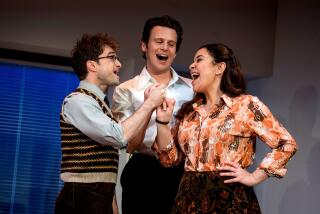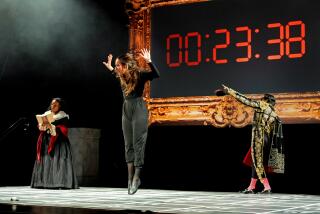‘West Side Story’ with a Spanish accent
When they got together at the Beverly Hills Hotel in August 1955, their legs dipping in the pool, Arthur Laurents and Leonard Bernstein were wrestling with a problem 3,000 miles away: They were trying to recast the “Romeo and Juliet” story for a modern-day musical set in New York, and their initial idea about Jews and Catholics battling each other wasn’t going anywhere.
Then they got an inspiration from the pages of the Los Angeles Times.
There had been stories about violent clashes between Latino gang members, and a new idea took root: “We decided to make the show about teenage gangs, to make it more timely,” said Laurents, who went on to write the book for the musical “West Side Story.” “Lennie wanted to set the action in Los Angeles, but I suggested New York. We had Puerto Rican gangs there, and the story would work well.”
Today, 52 years after the show opened, Laurents is pondering similar questions as an eagerly awaited revival of the legendary musical -- the first on Broadway in 29 years -- is set to open Thursday: How do you update a show that, despite its stellar reputation, can seem dated and even dramatically stale, given how theater and America have changed since “West Side Story” debuted in 1957?
As he sat at the back of the Palace Theatre, watching the cast rehearse “I Feel Pretty,” “Cool” and other classic numbers, Laurents, 91, heaved a sigh, recounting the path this revival has taken to the stage. At an age when others have slowed down dramatically, he remains sharply focused on the work at hand -- and cheerfully contentious when others quarrel with his new vision for the show.
“My biggest challenge is that, even in the age of Obama, there are people who don’t want change, certainly not in a show that’s considered a classic,” said Laurents, who is directing the revival. “But we had to change it. I couldn’t just do a replica of the original. We had to ask ourselves: Why are we doing it now?”
For those who love “West Side Story,” which is perhaps best known as an Oscar-winning 1961 movie, the answer would seem obvious: The show, powered by timeless numbers like “Maria,” “Tonight” and “Somewhere,” changed the face of American musical theater; it introduced subjects like murder, racism, gang violence and attempted rape into a genre accustomed to more genteel subjects.
The potent mix of Bernstein’s music, Stephen Sondheim’s lyrics, Laurents’ book and Jerome Robbins’ trailblazing choreography created a show that has been drilled into the American psyche. The clash between the Jets, a self-styled Anglo gang, and the Sharks, a Puerto Rican gang, is iconic, as is the story of Tony and Maria, two doomed lovers who try to rise above hatred and bigotry.
But that by itself is not enough for producers who are leery of gambling money at a time when the Great White Way has been hit hard by the recession. Although most believed “West Side Story” could be a hit revival, some were looking for a hook bigger than nostalgia to justify bringing the $14-million show to Broadway.
Kevin McCollum, who produced “Rent,” “Avenue Q,” “In the Heights” and “The Drowsy Chaperone,” asked Laurents to explore the idea of a revival, and the writer voiced similar concerns. In fact, he was initially reluctant to do the show, saying he was exhausted after directing a hit revival of “Gypsy,” which he had also written. But then he got a novel idea, again drawing on Latino material.
Tom Hatcher, his longtime partner, saw a Spanish-language production of “West Side Story” in Bogota, Colombia, and had been electrified by the 2006 show. He told Laurents that, for Spanish-speaking audiences, the Sharks were seen as the heroes and the Jets as villains. The language seemed to empower the Puerto Rican gang members, heightening their dramatic tensions with the Jets.
“It gave the show a new life, a new edge,” Laurents said. “The Sharks are isolated, they face terrible bigotry, and we could illustrate this now by using Spanish in key songs and scenes. It was the kind of change the show needed.”
But Laurents didn’t stop there. He wasn’t going to treat “West Side Story” like a museum piece, no matter how much aficionados might howl in protest. In his new version, he said, the prime emphasis would be on acting and dramatic realism.
“When you think of the original show, the ‘Jet Song’ treats these gang members like cute, adorable thugs doing a musical number,” he said. “But they weren’t that in 1957 any more than they are now. They’re bigoted killers. They’re uncaring.”
From the opening bars, the new production announces that this is not your parents’ “West Side Story.” As the Jets appear on stage, staring down arrogantly at the audience, the eerie, swinging notes of Bernstein’s “Prologue” begin. Then they stop abruptly, and resume, as other gang members appear. The flow of the cool, jazzy music -- so familiar to millions of listeners -- has been notably altered.
Was the Bernstein estate happy with this change, or did they make their peace with it? Laurents paused, smiled and said: “They made their peace with it.”
Sondheim embraced the use of Spanish lyrics, asking that the translation preserve the rhyme scheme, Laurents added. But some changes were radical, especially in “A Boy Like That,” sung by Maria and Anita, two Puerto Rican characters. The new translation was crafted by Lin-Manuel Miranda, who wrote and starred in “In the Heights,” the Tony-winning musical about Latinos in Upper Manhattan.
In the scene, Anita discovers that Maria has slept with Tony -- the Anglo who killed Bernardo, Anita’s lover and Maria’s brother. Her first line in the English version is: “A boy like that, he’d kill your brother.” Now it has been rewritten with much stronger language. Karen OIivo, who plays Anita in the revival, noted that the new line includes one of the most vulgar words to describe a man in the Spanish language. Miranda’s translation of another line -- “A boy like that wants one thing only, and when he’s done he’ll leave you lonely” -- is equally raw.
“There are Spanish-speaking people who will come to this show and they won’t be on the outside any longer; they’ll finally have the inside track,” said Olivo, whose ancestry is Puerto Rican, Dominican and Chinese. “I think of my mother coming to the show, who has loved musicals her whole life, even though with the language it’s been one-sided. Now, finally, Anita is speaking directly to her.”
Other cast members tell similar stories. Matt Cavenaugh, playing Tony, speaks new lines when he’s told at the end that Maria has been killed. He traditionally calls out to Chino, the killer, to “Come and get me!” in despair. Now he shouts angrily: “Come and get me, Chino -- and if you don’t kill me, I’ll kill you!”
“That earlier version was weepy, and I don’t do weepy,” Cavenaugh said. “We’ve tried to make Tony tougher.”
There were equally bold decisions in casting. Laurents first spotted Josefina Scaglione -- a little-known actress -- in a YouTube video in which she played Amber Van Tussle in an Argentine production of “Hairspray.” He was instantly smitten and flew her to New York, where she was cast as Maria soon afterward.
Laurents calls this the strongest “West Side Story” cast he’s ever seen. But how it will all play with the public -- and critics -- is anybody’s guess.
“We might get dinged by purists, we might not,” said McCollum. “But you can’t be static in the theater. The gang theme in this show can be applied to all sorts of divisions, including partisan politics. In so many ways, it’s a timeless story.”
And lucrative. “West Side Story” has grossed more than $1 million in weekly box office since previews began, racking up a solid $14 million in advance sales.
Laurents, however, says he’s focused solely on the show. And all this talk about tinkering with a Broadway masterpiece is beginning to give him a headache.
The original show, for example, ended with Jets and Sharks carrying Tony off stage in a poignant procession. In the revival, the curtain falls as a weeping Maria kneels over the body. A Jet offers her a shawl, and their hands clasp.
“The show has to be realistic,” Laurents said, explaining the new staging. “What cop in his right mind would let kids carry a body away from a crime scene?”
But don’t tell that to the unnamed producer who begged Laurents to switch the finale back to the original. Oh, and could they also sing “Somewhere” at the end?
“I got a phone call from him just this morning, asking if we could bring back the funeral procession, and I turned him down,” he said, shaking his head. “There’s been a lot of resistance to what we’re doing. With change, there always is.”
More to Read
The biggest entertainment stories
Get our big stories about Hollywood, film, television, music, arts, culture and more right in your inbox as soon as they publish.
You may occasionally receive promotional content from the Los Angeles Times.






